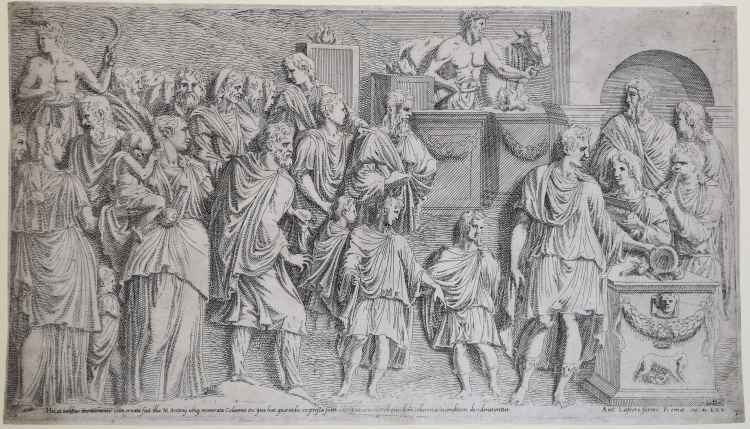



| Reference: | S10934 |
| Author | Leon DAVENT detto "Maestro L.D." |
| Year: | 1545 ca. |
| Measures: | 472 x 267 mm |


| Reference: | S10934 |
| Author | Leon DAVENT detto "Maestro L.D." |
| Year: | 1545 ca. |
| Measures: | 472 x 267 mm |
Marcus Antoninus offering a sacrifice in the presence of men, women and children gathered on the left.
Etching, 1550 circa, dated and signed with monogram at lower right. Example in the second state of three, with date and name of the publisher Antonio Lafrery added on lower right.
Magnificent work, printed on contemporary laid paper with “piligrim in the circle” watermark irregularly trimmed to the platemark or with thin borders, in excellent conditions. According to Bartsch and Zerner, this subject is after a drawing of Primaticcio, which has been inspired by the frieze on the Colonna Antonina in Rome, where the Emperor Trajan is however portrayed with the beard.
A drawing of the trajan column by Primaticcio, guarded in the Stadelsches Kunstinstitut in Frankfurt, shows that Davent’s work is the transposition of this very drawing, even though with some small changes. This piece is a rare example of those works of the Fontainbleu School that had been reprinted subsequently.
The examples of the second state, like this one, show the date 1565, and have been printed in Rome by the French publisher Lafreri.
The work belongs to the Speculum Romanae Magnificentiae, the earliest iconography of ancient Rome.
The Speculum originated in the publishing activities of Antonio Salamanca and Antonio Lafreri (Lafrery). During their Roman publishing careers, the two editors-who worked together between 1553 and 1563-started the production of prints of architecture, statuary, and city views related to ancient and modern Rome. The prints could be purchased individually by tourists and collectors, but they were also purchased in larger groups that were often bound together in an album. In 1573, Lafreri commissioned a frontispiece for this purpose, where the title Speculum Romanae Magnificentiae appears for the first time. Upon Lafreri's death, two-thirds of the existing copperplates went to the Duchetti family (Claudio and Stefano), while another third was distributed among several publishers. Claudio Duchetti continued the publishing activity, implementing the Speculum plates with copies of those "lost" in the hereditary division, which he had engraved by the Milanese Amborgio Brambilla. Upon Claudio's death (1585) the plates were sold - after a brief period of publication by the heirs, particularly in the figure of Giacomo Gherardi - to Giovanni Orlandi, who in 1614 sold his printing house to the Flemish publisher Hendrick van Schoel. Stefano Duchetti, on the other hand, sold his own plates to the publisher Paolo Graziani, who partnered with Pietro de Nobili; the stock flowed into the De Rossi typography passing through the hands of publishers such as Marcello Clodio, Claudio Arbotti and Giovan Battista de Cavalleris. The remaining third of plates in the Lafreri division was divided and split among different publishers, some of them French: curious to see how some plates were reprinted in Paris by Francois Jollain in the mid-17th century. Different way had some plates printed by Antonio Salamanca in his early period; through his son Francesco, they goes to Nicolas van Aelst's. Other editors who contributed to the Speculum were the brothers Michele and Francesco Tramezzino (authors of numerous plates that flowed in part to the Lafreri printing house), Tommaso Barlacchi, and Mario Cartaro, who was the executor of Lafreri's will, and printed some derivative plates. All the best engravers of the time - such as Nicola Beatrizet (Beatricetto), Enea Vico, Etienne Duperac, Ambrogio Brambilla, and others - were called to Rome and employed for the intaglio of the works.
All these publishers-engravers and merchants-the proliferation of intaglio workshops and artisans helped to create the myth of the Speculum Romanae Magnificentiae, the oldest and most important iconography of Rome. The first scholar to attempt to systematically analyze the print production of 16th-century Roman printers was Christian Hülsen, with his Das Speculum Romanae Magnificentiae des Antonio Lafreri of 1921. In more recent times, very important have been the studies of Peter Parshall (2006) Alessia Alberti (2010), Birte Rubach and Clemente Marigliani (2016).
Bibliografia
Alberti 112, II/III; Rubach, 291 II/III; Bartsch vol. XVI, p. 314, 14; Zerner 39, Le Beau Style pp. 96/97, 39; Huelsen 1921 143.b.
Leon DAVENT detto "Maestro L.D." (Attivo tra il 1540 ed il 1556 a Fontainebleau)
|
French engraver. Very little is known about his life and career. Only one of his engravings, the Apostles Contemplating Christ and the Virgin (1546) after Giulio Romano, bears a full name, ‘Lion Daven’; all the others have merely the monogram ‘L.D.’, under which his work is usually catalogued. Until Herbet’s study, this monogram was taken to be the signature of the Fleming Léonard Thiry. Davent made engravings from 1540, turning to etching c. 1543–4. Herbet attributed 221 plates to him, Zerner only 98.
|
Leon DAVENT detto "Maestro L.D." (Attivo tra il 1540 ed il 1556 a Fontainebleau)
|
French engraver. Very little is known about his life and career. Only one of his engravings, the Apostles Contemplating Christ and the Virgin (1546) after Giulio Romano, bears a full name, ‘Lion Daven’; all the others have merely the monogram ‘L.D.’, under which his work is usually catalogued. Until Herbet’s study, this monogram was taken to be the signature of the Fleming Léonard Thiry. Davent made engravings from 1540, turning to etching c. 1543–4. Herbet attributed 221 plates to him, Zerner only 98.
|